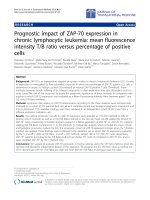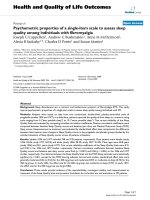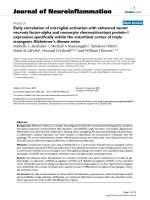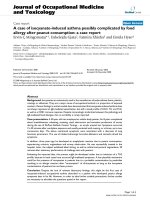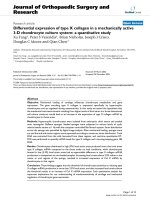báo cáo hóa học:"Early initiation of antiretroviral therapy results in decreased morbidity and mortality among patients with TB and HIV" ppt
Bạn đang xem bản rút gọn của tài liệu. Xem và tải ngay bản đầy đủ của tài liệu tại đây (237.55 KB, 6 trang )
BioMed Central
Page 1 of 6
(page number not for citation purposes)
Journal of the International AIDS
Society
Open Access
Short report
Early initiation of antiretroviral therapy results in decreased
morbidity and mortality among patients with TB and HIV
Payam Tabarsi*
1
, Ali S Saber-Tehrani
1
, Parvaneh Baghaei
1
, Mojgan Padyab
1
,
Davood Mansouri
1
, Majid Amiri
1
, Mohammad Reza Masjedi
1
and
Frederick L Altice
2
Address:
1
Mycobacteriology Research Center, National Research Institute of Tuberculosis and Lung Disease, Shahid Beheshti University of Medical
Science, Tehran, Iran and
2
Yale University AIDS Program, New Haven, CT, USA
Email: Payam Tabarsi* - ; Ali S Saber-Tehrani - ; Parvaneh Baghaei - ;
Mojgan Padyab - ; Davood Mansouri - ; Majid Amiri - ;
Mohammad Reza Masjedi - ; Frederick L Altice -
* Corresponding author
Abstract
Introduction: The overlapping drug toxicity profiles, drug-drug interactions and complications of
management of both HIV and tuberculosis (TB) in patients with advanced HIV have not been fully
delineated.
Methods: We conducted a retrospective chart review of the outcomes of tuberculosis treatment
among 69 HIV-infected patients with TB, who were hospitalized in Masih Daneshvari Hospital in
Tehran, Iran between 2002 and 2006, and who received standard category 1 (CAT-1) regimens.
Group I (N = 47) included those treated from 2002 to 2005 with highly active antiretroviral therapy
(HAART) initiated after eight weeks of TB treatment for those whose CD4 count was <200 cells/
mm
3
. Group II (N = 22) included TB patients treated from 2005 to 2006, with HAART initiated
after two weeks of TB treatment if their CD4 count was <100 cells/mm
3
and eight weeks after
initiation of TB treatment for those whose CD4 count was between 101 and 200 cells/mm
3
.
Results: There were no differences between Groups I and II with regard to: adverse drug
reactions [four (8.5%) versus two (9%), p = ns]; IRIS [six (12.7%) versus three (10.7%), p = ns]; and
new opportunistic infections [eight (17.0%) versus two (9.1%), p = ns]. Death, however, occurred
more frequently in Group I than in Group II [13 (27.7%) versus (4.5%), p = 0.03], where HAART
was initiated earlier. Injection of drugs was the most common route of HIV transmission in both
groups (72.3% in Group I and 77.3% in Group II).
Conclusion: This manuscript shows that in a retrospective review of HIV/TB patients hospitalized
in Tehran, improved survival was associated with earlier initiation of antiretroviral therapy in HIV/
TB patients with CD4 counts of below 100 cells/mm
3
.
Published: 16 July 2009
Journal of the International AIDS Society 2009, 12:14 doi:10.1186/1758-2652-12-14
Received: 2 October 2008
Accepted: 16 July 2009
This article is available from: />© 2009 Tabarsi et al; licensee BioMed Central Ltd.
This is an Open Access article distributed under the terms of the Creative Commons Attribution License ( />),
which permits unrestricted use, distribution, and reproduction in any medium, provided the original work is properly cited.
Journal of the International AIDS Society 2009, 12:14 />Page 2 of 6
(page number not for citation purposes)
Findings
Multiple complications in the co-management of HIV and
TB have been documented or suggested, including: over-
lapping medication toxicity profiles; pharmacokinetic
drug interactions; premature death from non-tuberculosis
causes; development of resistant TB; and immune recon-
stitution reactions [1-3]. Recent data suggest that, with
careful attention to these complicating factors, the mortal-
ity associated with HIV-related TB is substantially reduced
with the provision of HAART [4], yet data conflict with
regard to CD4 count cut-offs and consequences of the
immune reconstitution syndrome [5].
In this study, we compare the clinical treatment outcomes
of HIV and TB co-infected patients treated with HAART,
considering a delayed versus immediate HAART approach
among hospitalized patients in an academic medical cen-
tre in Tehran, Iran.
We conducted a retrospective chart review of all HIV-pos-
itive patients diagnosed with tuberculosis from 2002 to
2006 at the Masih Daneshvari Medical Center; the chart
review continued for an additional year to evaluate clini-
cal outcomes.
From 2002 to 2005, the Iranian national guidelines for
management of TB among HIV-positive patients included
initiation of HAART eight weeks after initiation of treat-
ment for TB if patients' CD4 count was <200 cells/mm
3
.
In 2005, our centre changed its guidelines to initiate
HAART concurrently with TB treatment if the CD4 count
was <100 cells/mm
3
and to delay treatment of HIV for
eight weeks if the CD4 count was 101 to 200 cells/mm
3
.
During this time period, all TB patients received anti-
tuberculosis medications as directly observed therapy and
in accordance with standard Category 1 (CAT-1) regi-
mens.
Group I was made up of patients receiving TB treatment
according to the time period stipulated by the previous
guidelines; Group II consisted of those treated in accord-
ance with the newer guidelines. Based on the Drug Sus-
ceptibility Test (DST), the regimen was changed according
to drug resistance pattern.
Tuberculosis treatment outcomes were measured in
accordance with standard WHO definitions [6]. HIV treat-
ment strategies differed during the two treatment periods
as well. Treatment outcomes were defined as those identi-
fied within 12 months after diagnosis of TB. The presence
of a new opportunistic infection diagnosed during the
first 12 months after diagnosis included only those oppor-
tunistic infections that were new for the patient.
Medication adverse consequences were documented from
the medical record, and laboratory grading of adverse
events were in accordance with the ACTG guidelines [7].
Immune reconstitution syndrome was defined according
to criteria proposed by French et al [8].
From 2002 to 2005, HAART was initiated with zidovu-
dine, lamivudine and nelfinavir. At the time of HAART
initiation, administration of rifampin, as part of CAT-1
treatment, was changed to rifabutin, 150 mg daily. From
2005 to 2006, efavirenz became available and was dosed
at 600 mg per day, and rifampin was continued.
Prophylactic regimens against opportunistic infections
were provided in accordance with national guidelines
during both time periods of the study. This included tri-
methoprim/sulfamethoxazole for CD4 counts of <200
cells/mm
3
and azithromycin, 1200 mg weekly, for CD4
counts of <50 cells/mm
3
.
For the purposes of this study, we developed a definition
of adverse consequence as the development of a Grade 3
or greater laboratory event, development of a new oppor-
tunistic infection or immune reconstitution syndrome
(IRS), or death. The research was approved and conducted
in accordance with an institutional review board.
Statistical data analysis was performed using SPSS v. 13.0
software (Apache Software Foundation, Chicago, Illi-
nois). Chi square testing was performed to determine the
bivariate differences between comparisons. The Student's
t-test and Mann-Whitney U test were used for variables
with normal distribution and non-normal distribution
data respectively. Logistic regression was used to adjust
baseline demographic characteristics between the two
groups. Kaplan-Meier survival curves were created for time
to death.
The baseline demographic and clinical characteristics of
subjects in Groups I and II are provided in Table 1. The
mean age in Group I and Group II was 33.3 ± 7.9 and 37.8
± 6.3 respectively. All of patients in Group I were male.
Injection drug use was the most common route (73.9%)
of HIV transmission, and most of the patients (87%) had
a history of imprisonment. The mean CD4 count was 204
± 184.06 in Group I. The median CD4 count statistically
differed between the two groups, as did the proportion
with extra-pulmonary TB. Baseline resistance did not dif-
fer between the two groups. The number of patients co-
infected with the hepatitis C virus (HCV) was 38 and 15
in Group I and Group II respectively.
Table 2 provides the treatment outcomes of the two
groups. The most common adverse reaction was drug-
Journal of the International AIDS Society 2009, 12:14 />Page 3 of 6
(page number not for citation purposes)
induced hepatitis, which occurred in 14.5% of the
patients. The proportion of subjects with IRS was 13%,
and adverse cutaneous reactions occurred in 7.7% of sub-
jects. No difference was observed between the two groups
for any of these complications of therapy. The Kaplan-
Meier curve for HIV and TB co-infected patients is shown
in Figures 1 and 2. Death, within 12 months after diagno-
sis, was 7.2 times more likely in Group I than in Group II
(95% confidence interval 1.87–27.64, p value = 0.03).
The causes of death in Group 1 were TB (10 cases), and
primary CNS lymphoma, CMV and cryptococal meningi-
tis (one case for each). TB was the cause of the only death
in Group II. The CD4 count median among patients who
died in Group I was 77.5 cells/mm
3
, while the only
patient who died in Group II had a CD4 count of 52 cells/
mm
3
. The outcome for patients, based on the DST pattern,
is shown in Table 3.
Though the study size is small and limited by non-con-
temporaneous treatment approaches, this study suggests
that immediate treatment with antiretroviral therapy in
patients with TB and advanced HIV markedly improves
survival without increasing adverse consequences (Figure
2). However, the study could not confirm this because:
the two groups received different treatment at different
times; and many other factors may have influenced the
result, such as changing antiretroviral therapy from nelfi-
navir to efavirenz. The definitive answer to the optimal
timing of ART requires a randomized clinical study.
Nevertheless, the study's suggestion is particularly rele-
vant in that nearly three quarters of this study population
acquired HIV from injection drug use, and were highly
likely to be co-infected with HCV. In other studies of treat-
ment for HIV among HCV co-infected patients, develop-
ment of Grade 3/4 hepatotoxicity is markedly increased.
This study, however, suggests little, if any, excess hepato-
Table 1: Baseline characteristics of subjects
Subject characteristics Group I
2002–2005
%Group II
2005–2007
% P value
N = 47 N = 22
Mean age (years) 33.3 ± 7.9 37.8 ± 6.3 0.016
Gender
• Male 44 93.6 22 100
• Female 3 6.4 0 0
HIV diagnosis at hospital 43 91.5 16 72.7 0.064
Prior OI (%) 0 0 0 0
HBV co-infected 2 4.3 2 9.1 0.587
HCV co-infected 38 80.9 15 68.2 0.245
Type of TB
• Pulmonary only 31 66 19 86.4 0.08
• Disseminated 16 34 3 13.6
TB drug susceptibility
• Unknown 18 38.3 7 31.8 0.485
• Pan-sensitive 15 31.9 11 50
• Single drug resistance 7 14.9 3 13.6
• Poly-drug resistance 4 8.5 0 0
• Multi-drug resistance 3 6.4 1 4.5
Mean CD4 lymphocyte count at diagnosis (+/- SD) 204 ± 184.06 164.7 ± 200.9 0.20
• Median CD4 lymphocyte count 132 60
• CD4 ≤ 100 cells/mm
3
15 13
• CD4 101–200 cells/mm
3
26 9 0.22
Journal of the International AIDS Society 2009, 12:14 />Page 4 of 6
(page number not for citation purposes)
toxicity compared to other similar study populations. In
other studies of treatment for HIV and TB, the presence of
Grade 3/4 hepatotoxicity ranges from 6% to 18% in non-
drug-using populations [9].
Our study, with nearly three quarters acquiring HIV infec-
tion from injection drug use, suggests the safety of TB and
HIV treatment among injection drug users. Though IRS
has been reported in as many as 30% to 40% of TB
patients starting HAART, this study, in line with some
recent publications [10,11], suggests that this occurs less
frequently than previously reported and does not result in
discontinuation of either HIV or TB treatment. The pro-
portion of patients with rash in our study is similar to that
reported among patients treated with non-nucleoside
reverse transcriptase inhibitors (NNRTIs) who were not
TB co-infected [12]. In our study, no one discontinued
treatment for either IRS or rash; however, a few patients'
NNRTIs were changed to alternative regimens.
While consensus is beginning to develop, the appropriate
time to initiate HAART in TB/HIV patients remains con-
troversial [13], and it will remain so until systematic and
prospective randomized controlled trials can be com-
pleted. While other studies demonstrate the markedly
increased risk for death among TB/HIV patients whose
HIV is not treated when the CD4 count is ≤ 50 cells/mm
3
,
our study suggests that benefit is derived with earlier treat-
ment for CD4 counts that are up to 100 cells/mm
3
.
Table 2: Clinical responses to treatment
Response to treatment Group I (N = 47)
2002–2005
Group II (N = 22)
2005–2007
P value
N% N%
Initial HAART regimen
• Nelfinavir-containing regimen 47 100
• Efavirenz-containing regimen 22 100
Discontinued HAART within one year of initiation
Laboratory ASEs* (Grade 3 or 4)
• Grade 3 4 8.5 1 4.5 0.9
• Grade 4 0 0 1 4.5 0.319
New opportunistic infections (overall) 8 17.0 2 9.1 0.484
• CNS toxoplasmosis 6 12.8 0 0
• CMV retinitis 1 2.1 0 0
• PCP pneumonia 0 0 2 9.1
• Cryptococcal infection 1 2.1 0 0
TB outcomes
• Cure 22 46.8 19 86.4 0.002
• Treatment failure 12 25.5 2 9.1 0.198
Death within 12 months 13 27.7 1 4.5 0.028
• Median time to death (days) 60 NA
* Adverse side effects
Journal of the International AIDS Society 2009, 12:14 />Page 5 of 6
(page number not for citation purposes)
Though the sample size was small and did not achieve sta-
tistical significance, this study confirms the high rate of
opportunistic infections among those initiating HAART
after eight weeks of TB treatment.
Surprising in our data was the observation of high rates of
toxoplasmosis and pneumocystis pneumonia (PCP)
among a group on TMP/SMZ for PCP prophylaxis [14].
One explanation is that patients who were prescribed PCP
prophylaxis did not take it. While others have noted that
non-adherence to one medication is associated with non-
adherence to another [15], patients received their TB med-
ications as directly observed therapy while their prophy-
laxis and HIV medications were self-administered.
Though not a primary goal of this retrospective study, the
high rate of HIV diagnosis coincident with TB diagnosis
among injection drug users and former prisoners provides
a strong argument for more routine testing of these indi-
viduals. Prior identification of HIV may have led to:
increased INH preventive therapy; earlier initiation of
HAART and possibly avoiding development of TB and
other opportunistic infections; engagement in methadone
treatment for stabilization of opioid dependence; engage-
ment in health; and less exposure to TB in congregate set-
tings like prisons [16,17].
Kaplan-Meier curve of HIV/TB co-infected patients and time to deathFigure 1
Kaplan-Meier curve of HIV/TB co-infected patients
and time to death.
Kaplan-Meier curve of HIV/TB co-infected patients with CD4 count less than 100 cells/mm
3
(p value = 0.0335)Figure 2
Kaplan-Meier curve of HIV/TB co-infected patients
with CD4 count less than 100 cells/mm
3
(p value =
0.0335).
Survival Functions
FOLLOWUP
20100-10
Cum Survival
1.1
1.0
.9
.8
.7
.6
.5
SERI
prompt
prompt-censored
after2
after2-censored
Table 3: Outcomes of patients based on DST pattern
DST Outcome of Group 1 (N = 47) Outcome of Group 2 (N = 22)
Cure Death Failure Cure Death Failure
Unknown 5
(22.7%)
8
(61.5%)
5
(41.7%)
5
(26.3%)
1
(100%)
1
(50%)
Sensitive 10
(45.5%)
3
(23.1%)
2
(16.7%)
11
(57.9%)
00
Mono-drug resistant 4
(18.2%)
1
(7.7%)
2
(16.7%)
2
(10.5%)
01
(50%)
Poly-drug resistant 2
(9.1%)
02
(16.7%)
000
MDR 1
(4.5%)
1
(7.7%)
1
(8.3%)
1
(5.3%)
00
Publish with BioMed Central and every
scientist can read your work free of charge
"BioMed Central will be the most significant development for
disseminating the results of biomedical research in our lifetime."
Sir Paul Nurse, Cancer Research UK
Your research papers will be:
available free of charge to the entire biomedical community
peer reviewed and published immediately upon acceptance
cited in PubMed and archived on PubMed Central
yours — you keep the copyright
Submit your manuscript here:
/>BioMedcentral
Journal of the International AIDS Society 2009, 12:14 />Page 6 of 6
(page number not for citation purposes)
Although this study was retrospective and had limitations,
such as being hospital based and having a limited number
of patients, overall it marks the importance of rapid initi-
ation of HAART in TB/HIV patients with advanced HIV
infection (CD4 count of <100 cell/mm
3
).
Competing interests
The authors declare that they have no competing interests.
Authors' contributions
PT participated in the design of the study, collecting data,
analyzing and preparing the manuscript. AS participated
in collecting data and preparing the manuscript. PB partic-
ipated in collecting data and analyzing data. MP partici-
pated in analyzing data. MA participated in the design of
the study. DM participated in the design of the study and
preparing the manuscript. MM participated in the design
of the study. RA participated in the design of the study and
preparing the manuscript. All authors read and approved
the final manuscript.
References
1. Dean GL, Edwards SG, Ives NJ, Matthews G, Fox EF, Navaratne L,
Fisher M, Taylor GP, Miller R, Taylor CB, de Ruiter A, Pozniac AL:
Treatment of tuberculosis in HIV-infected persons in the era
of highly active antiretroviral therapy. AIDS 2002, 16(1):75-83.
2. McIlleron H, Meintjes G, Burman WJ, Maartens G: Complications
of antiretroviral therapy in patients with tuberculosis: drug
interactions, toxicity, and immune reconstitution inflamma-
tory syndrome. J Infect Dis 2007, 196(Suppl 1):S63-75.
3. Onyebujoh PC, Ribeiro I, Whalen CC: Treatment options for
HIV-associated tuberculosis. J Infect Dis 2007, 196(Suppl
1):S35-45. Review
4. CDC/USPHS/IDSA: Guidelines for the treatment of opportun-
istic infections among HIV-infected adults and adolescents.
MMWR 2004, 53:1-112.
5. Murdoch DM, Venter WD, Van Rie A, Feldman C: Immune recon-
stitution inflammatory syndrome (IRIS): review of common
infectious manifestations and treatment options. AIDS Res
Ther 2007, 4:9.
6. World Health Organization: TB/HIV – a clinical manual. Geneva;
WHO; 2004.
7. AIDS Clinical Trials Group: Table of grading severity of adult
adverse experiences. US Division of AIDS, National Institute of
Allergy and Infectious Diseases, Rockville, MD, Bethesda; 1996.
8. French MA, Price P, Stone SF: Immune restoration disease after
antiretroviral therapy. AIDS 2004, 18(12):1615-27.
9. Tostmann A, Boeree MJ, Aarnoutse RE, de Lange WC, van der Ven
AJ, Dekhuijzen R, et al.: Antituberculosis drug-induced hepato-
toxicity: concise up-to-date review. J Gastroenterol Hepatol 2008,
23(2):192-202.
10. Manabe YC, Campbell JD, Sydnor E, Moore RD: Immune reconsti-
tution inflammatory syndrome: risk factors and treatment
implications. J Acquir Immune Defic Syndr 2007, 46(4):456-62.
11. Serra FC, Hadad D, Orofino RL, Marinho F, Lourenco C, Morgado M,
Rolla V: Immune reconstitution syndrome in patients treated
for HIV and tuberculosis in Rio de Janeiro. Braz J Infect Dis
2007, 11(5):462-5.
12. Sheran M: The nonnucleoside reverse transcriptase inhibitors
efavirenz and nevirapine in the treatment of HIV. HIV Clin Tri-
als 2005, 6(3):158-68.
13. Sungkanuparph S, Manosuthi W, Kiertiburanakul S, Vibhagool A: Ini-
tiation of antiretroviral therapy in advanced AIDS with
active tuberculosis: clinical experiences from Thailand. J
Infect 2006, 52(3):188-94.
14. Maher D, Harries A, Getahun H: Tuberculosis and HIV interac-
tion in sub-Saharan Africa: impact on patients and pro-
grammes; implications for policies. Trop Med Int Health 2005,
10(8):734-42.
15. McNabb JJ, Nicolau DP, Stoner JA, Ross J: Patterns of adherence
to antiretroviral medications: the value of electronic moni-
toring. AIDS 2003, 17(12):1763-7.
16. Liddicoat RV, Zheng H, Internicola J, Werner BG, Kazianis A, Golan
Y, Rubinstein EP, Freedberg KA, Walensky RP: Implementing a
routine, voluntary HIV testing program in a Massachusetts
county prison. J Urban Health 2006, 83(6):1127-31.
17. Hammett TM: HIV/AIDS and other infectious diseases among
correctional inmates: transmission, burden, and an appro-
priate response. Am J Public Health 2006, 96(6):974-978.


